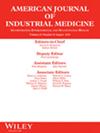Substance Use Right Before or During Work Among the Young US Workers: Evidence From the National Longitudinal Survey of Youth 1997 Cohort
Abstract
Objective
Substance use right before or during work (hereinafter, “substance use in the workplace”) poses significant health risks to users, colleagues, and the public in the workplace. However, less clear are figures on recent prevalence, characteristics of those engaging in such behaviors, and variations across occupations. This study examines the prevalence of substance use in the workplace, individual and work-related characteristics, and substance use risks across different occupations among a nationally representative sample of workers in their early 30 s—a period of heightened substance use.
Methods
Data from the National Longitudinal Survey of Youth 1997 (NLSY97) were analyzed, focusing on 6155 respondents. Past-month prevalence of substance use in the workplace (separately for any substance, alcohol, marijuana, and cocaine/hard drugs) was assessed overall and by occupation using the Census 2002 Standard Occupational Classification. Multivariable Poisson regression models tested associations between occupation and substance use, adjusting for sociodemographic and health-related characteristics.
Results
In the past month, 8.9% of workers reported any substance use in the workplace, including 5.9% for alcohol, 3.1% for marijuana, and 0.8% for cocaine/hard drugs. Prevalence was highest in food preparation/serving occupations, followed by safety-sensitive occupations. Our models indicated higher risks for all types of substance use among food preparation/serving workers, higher alcohol use among white-collar workers, and elevated alcohol and marijuana use in safety-sensitive occupations.
Conclusions
The substantial prevalence of workforce substance use among individuals in their early 30 s raises public health concerns, underscoring the need for workplace interventions addressing occupation-specific patterns of alcohol and marijuana use.


 求助内容:
求助内容: 应助结果提醒方式:
应助结果提醒方式:


